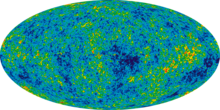
Back حقبة الهادرون Arabic হ্যাড্রন অধিযুগ Bengali/Bangla Època hadrònica Catalan Hadronová éra Czech Época hadrónica Spanish دوره هادرون Persian Hadroniepookki Finnish Ère hadronique French Zaman hadron ID ハドロン時代 Japanese
| Part of a series on |
| Physical cosmology |
|---|
 |
In physical cosmology, the hadron era[1]: 209 is said to have begun at a time of 10-44 seconds, or at 10-8 seconds[2], and ended at 10-4 seconds. The temperature was high enough to allow the formation of hadron/anti-hadron pairs, which kept matter and anti-matter in thermal equilibrium.
However, hadron-antihadron pairs were only abundant for a brief time between about 5×10-5 seconds, the time of the QCD phase transition, and about 7×10-5 seconds, when the temperature of the universe dropped below the pion mass.[3] Before the QCD phase transition, during the quark epoch, the universe was hot enough that quarks did not combine to form hadrons. At temperatures below the pion mass, most of the hadrons and anti-hadrons were eliminated in annihilation reactions, leaving the Universe dominated by photons, neutrinos and electron-positron pairs. This subsequent period is referred to as the lepton era.[2]
- ^ Kleczek, Josip (1976). The Universe. Episteme Ser. Dordrecht: Springer Netherlands. ISBN 978-94-010-1485-4.
- ^ a b Karttunen, Hannu; Kröger, Pekka; Oja, Heikki; Poutanen, Markku; Donner, Karl Johan, eds. (2003). Fundamental astronomy. Physics and astronomy (4 ed.). Berlin Heidelberg: Springer. ISBN 978-3-540-00179-9.
- ^ Husdal, Lars (17 December 2016). "On Effective Degrees of Freedom in the Early Universe". Galaxies. 4 (4): 78. arXiv:1609.04979. Bibcode:2016Galax...4...78H. doi:10.3390/galaxies4040078.